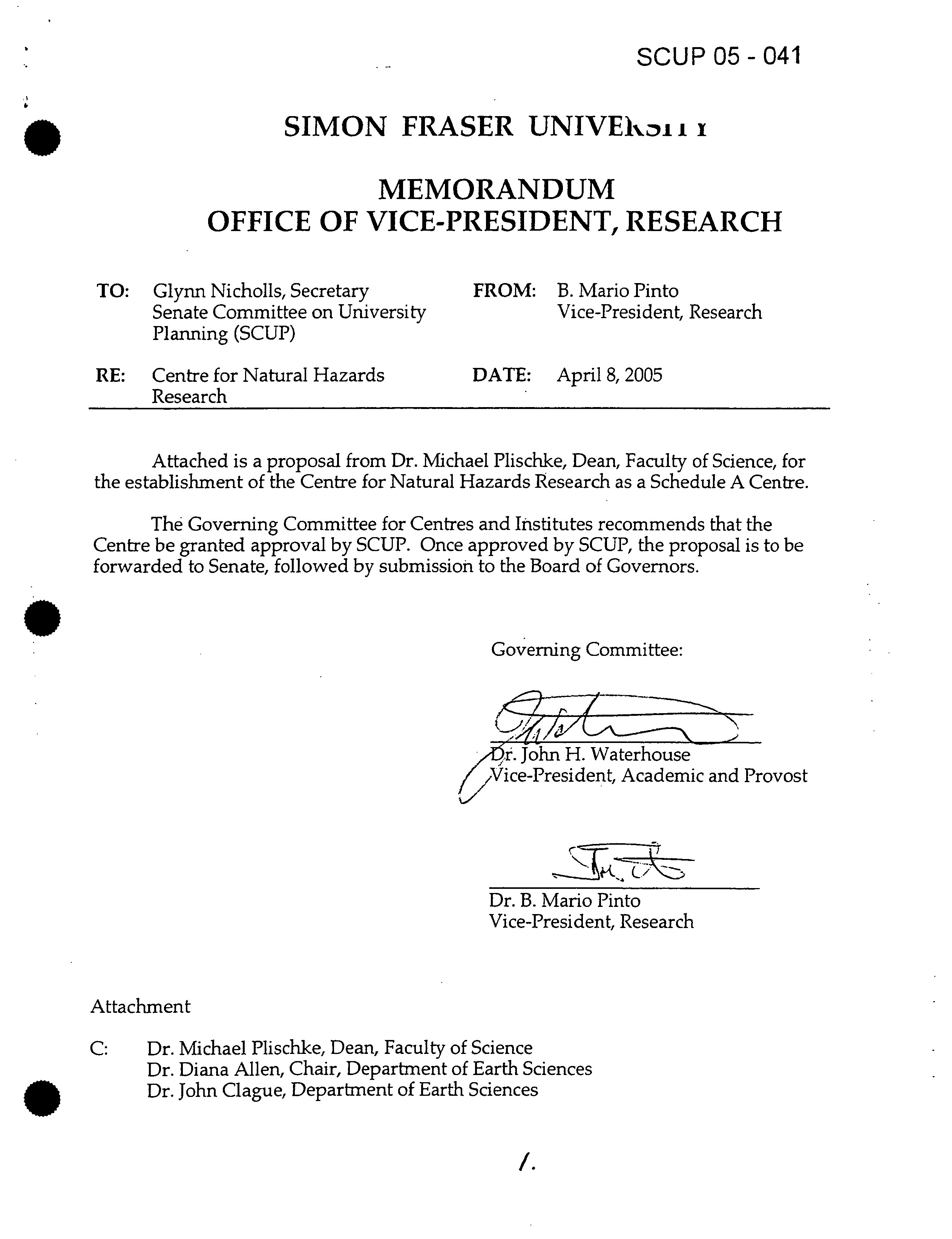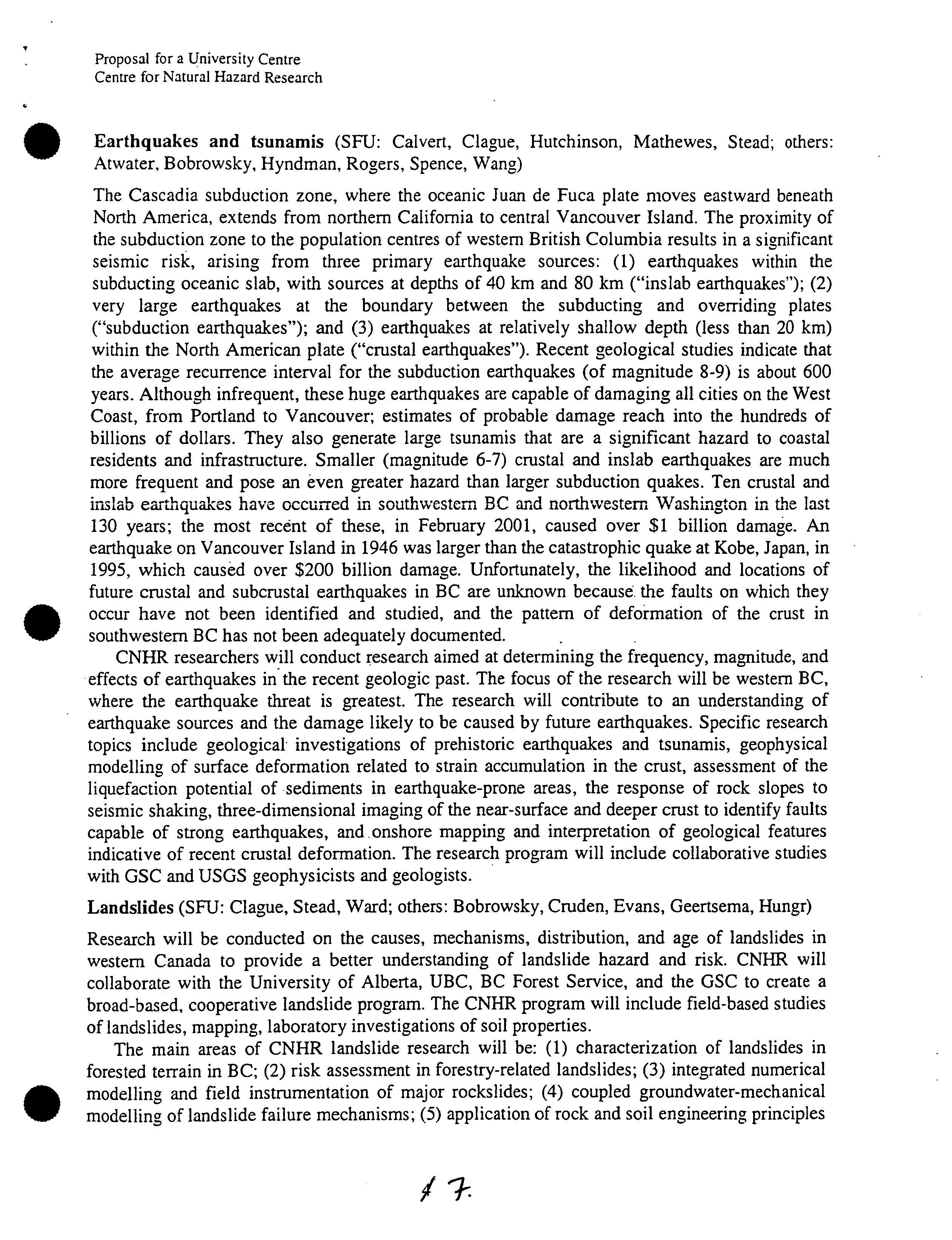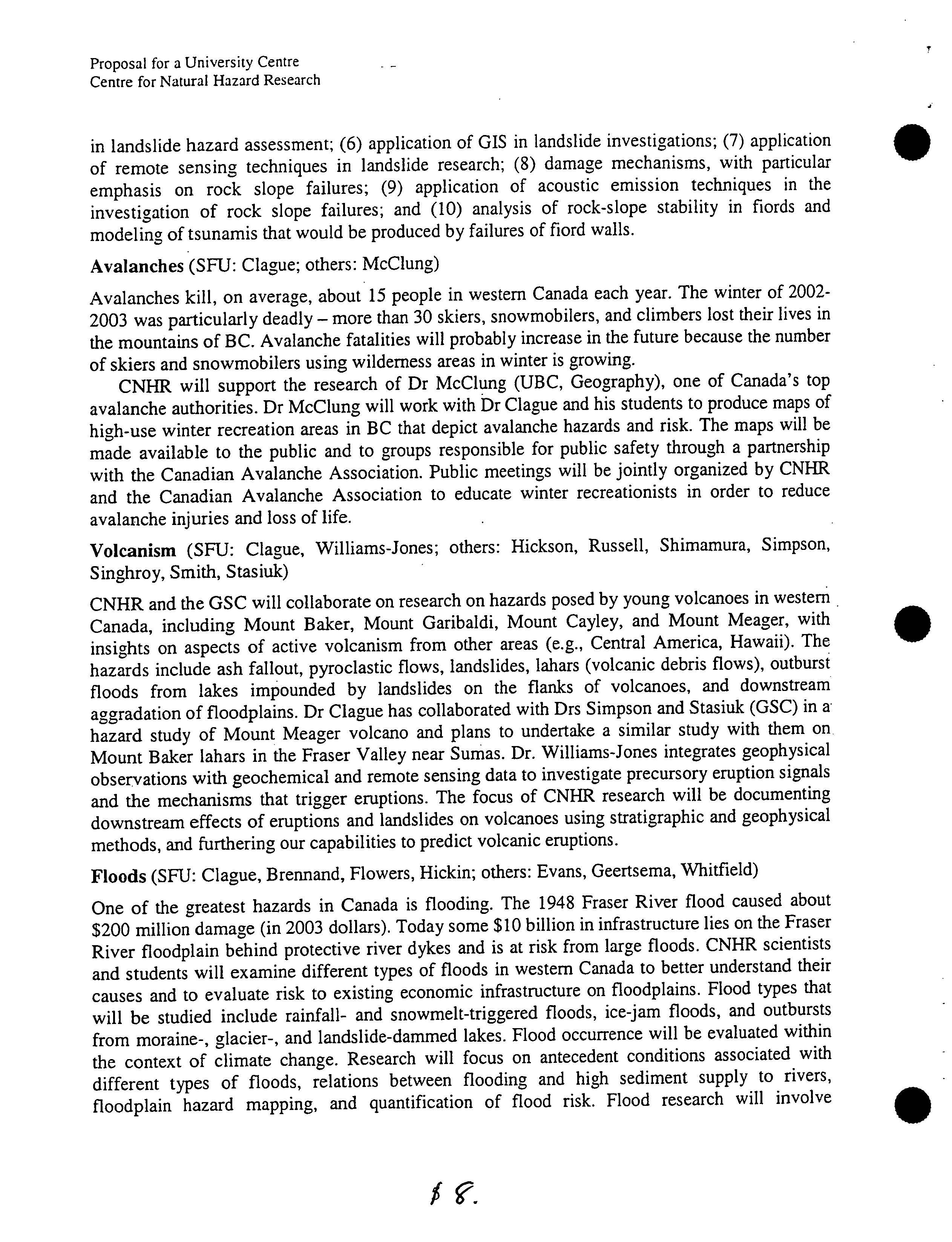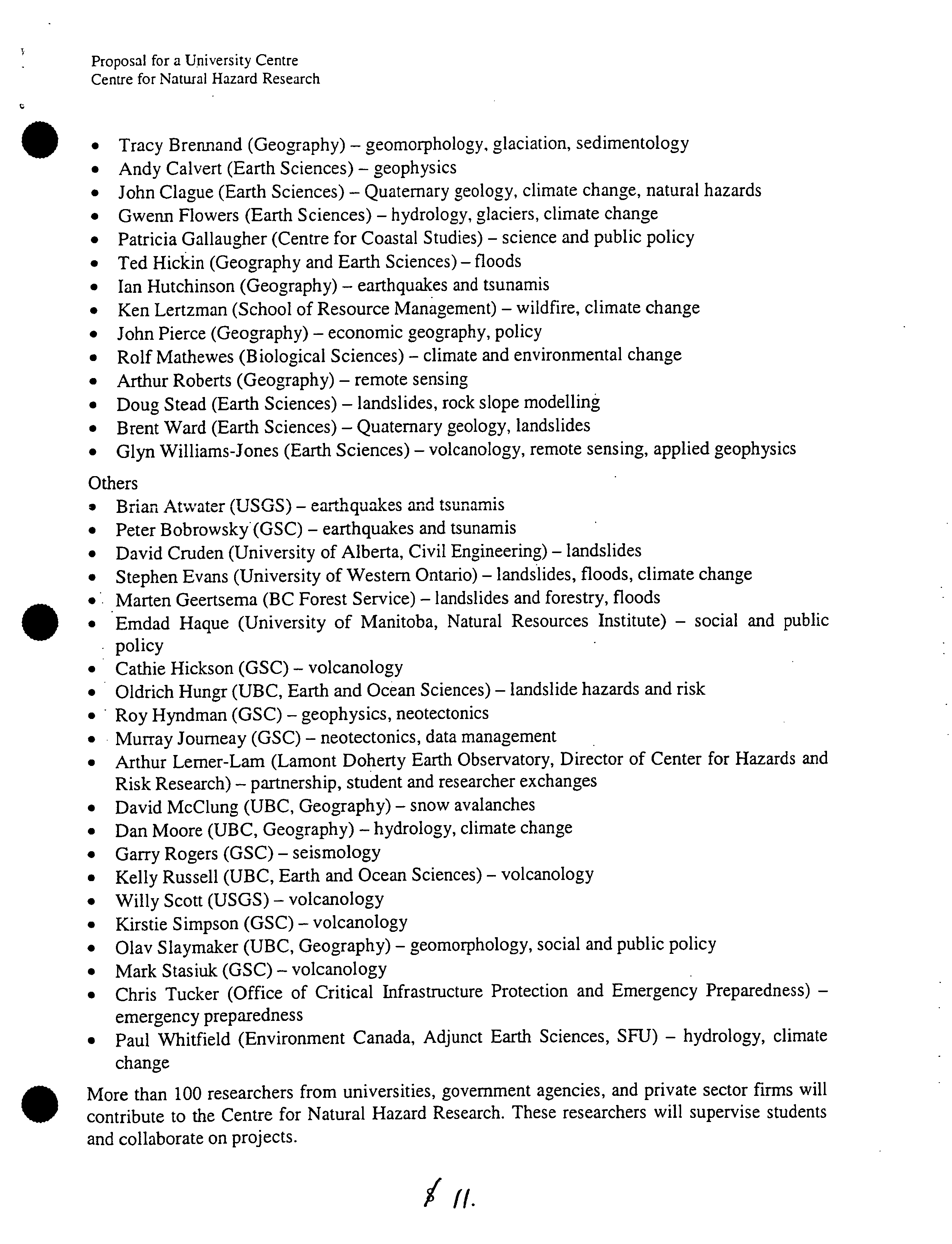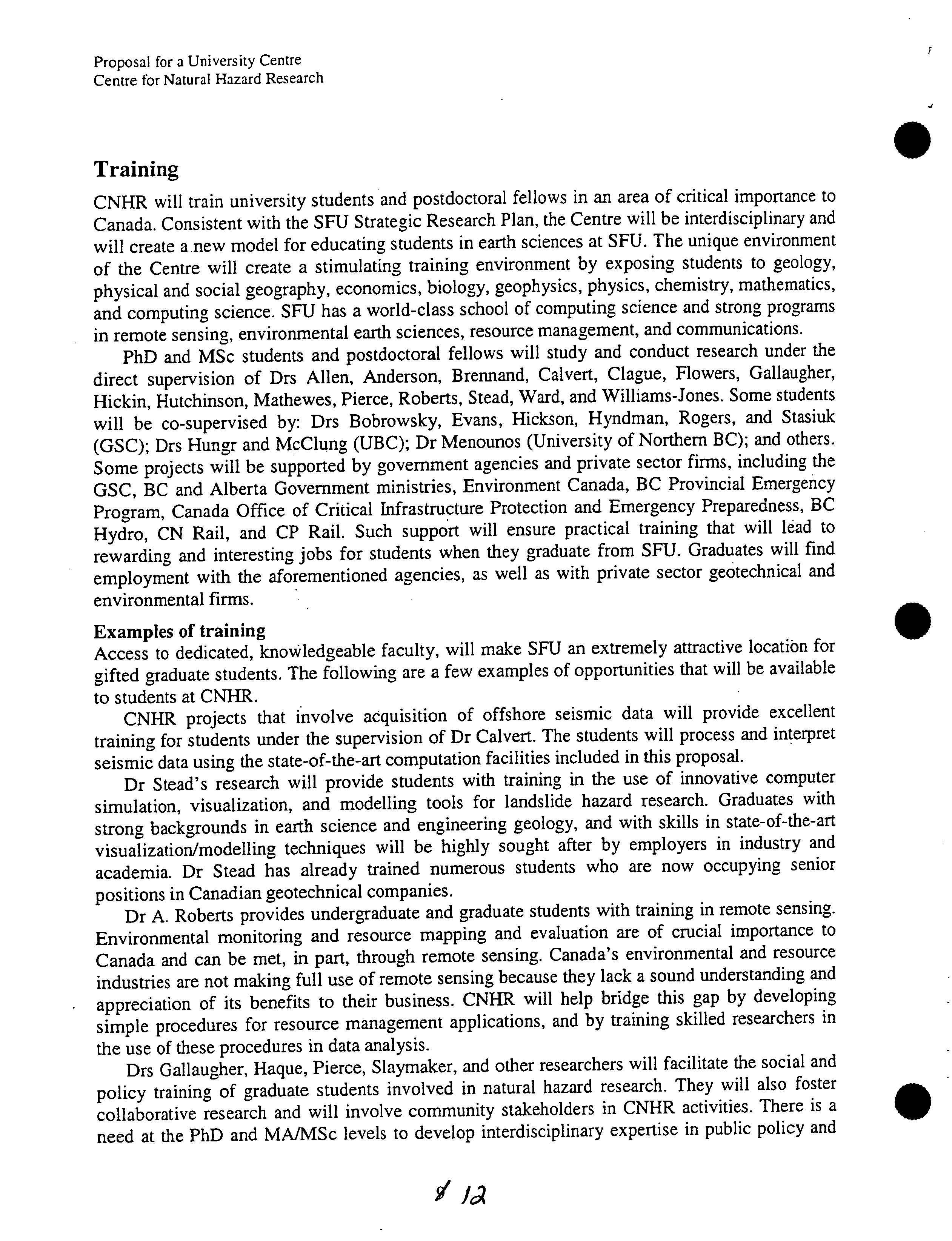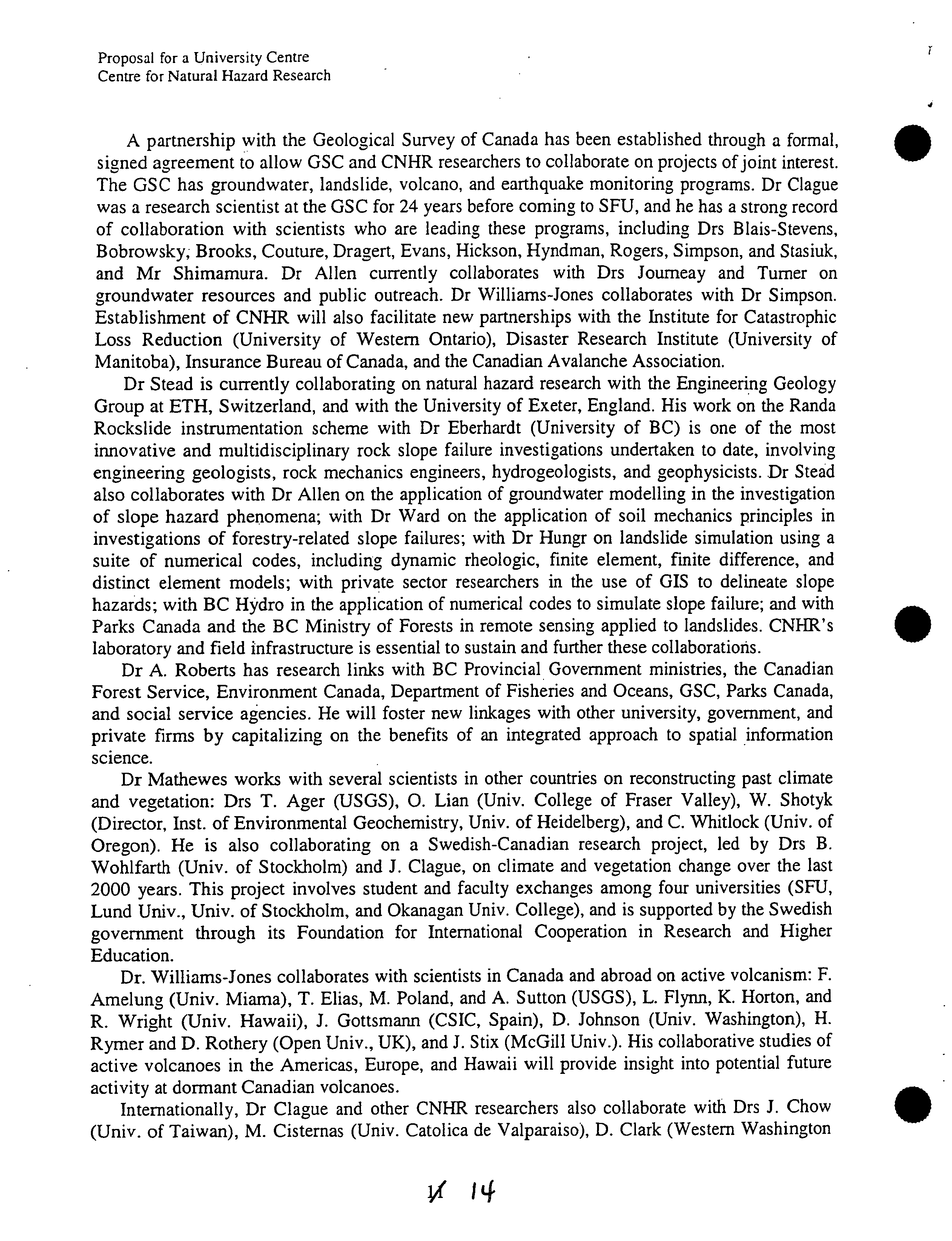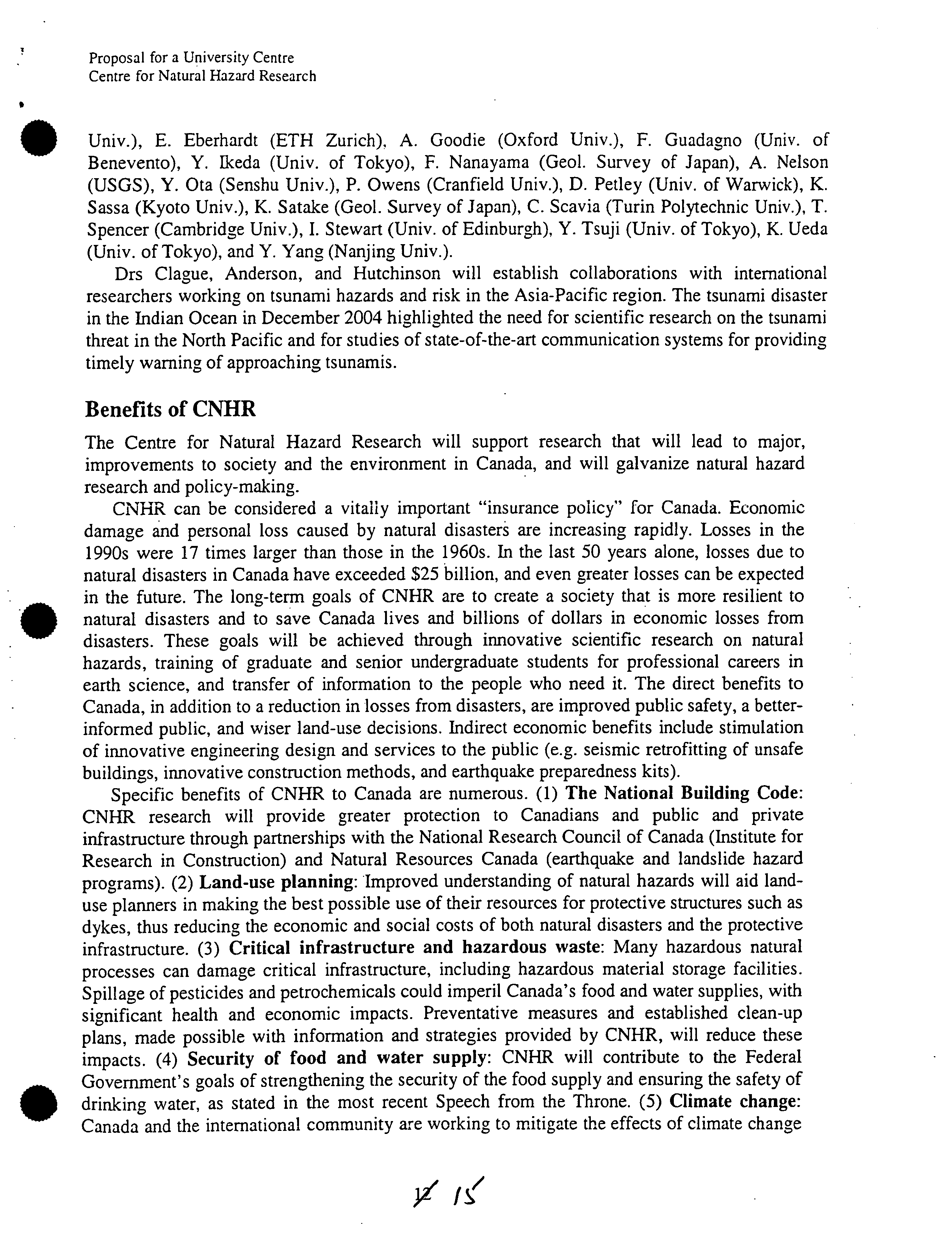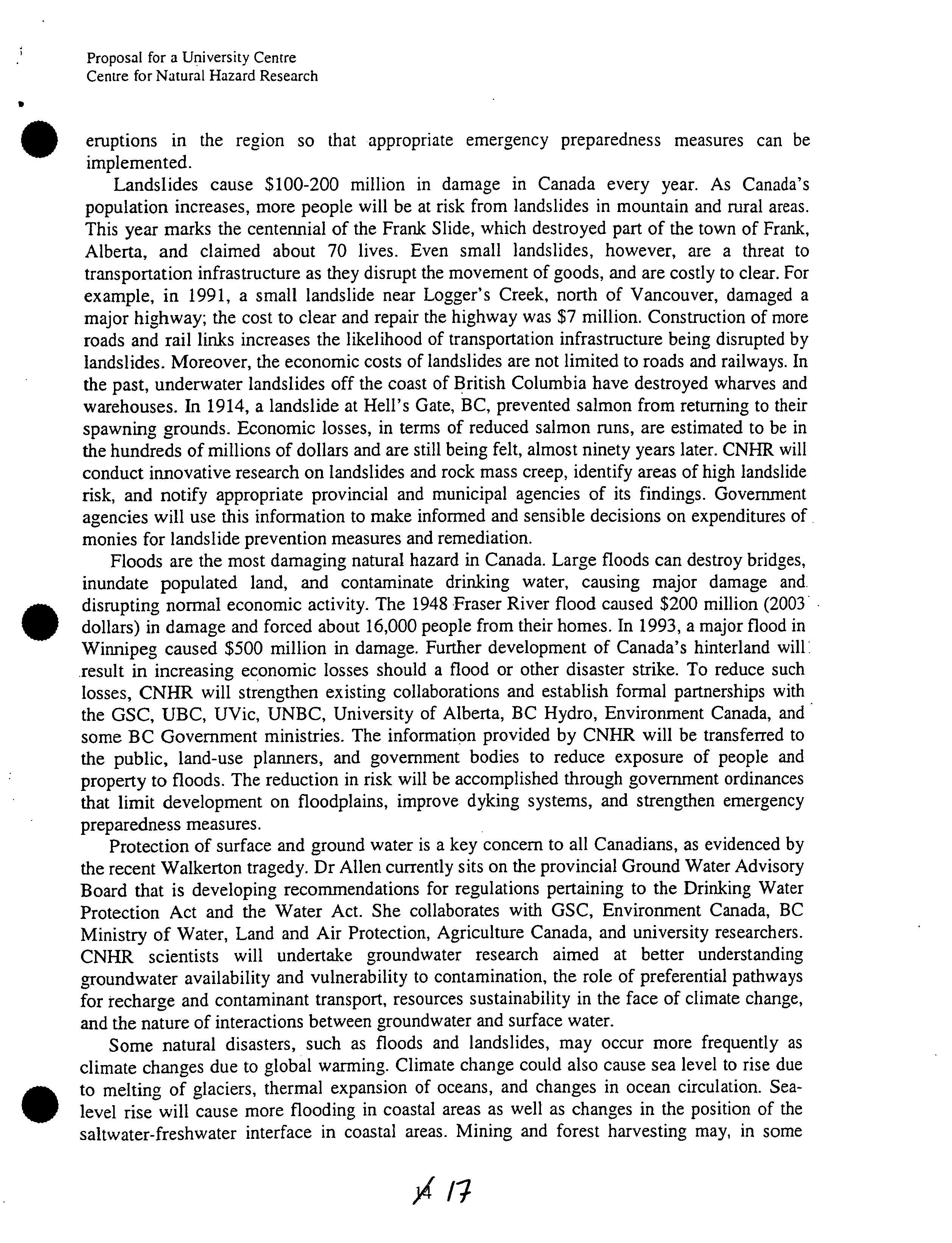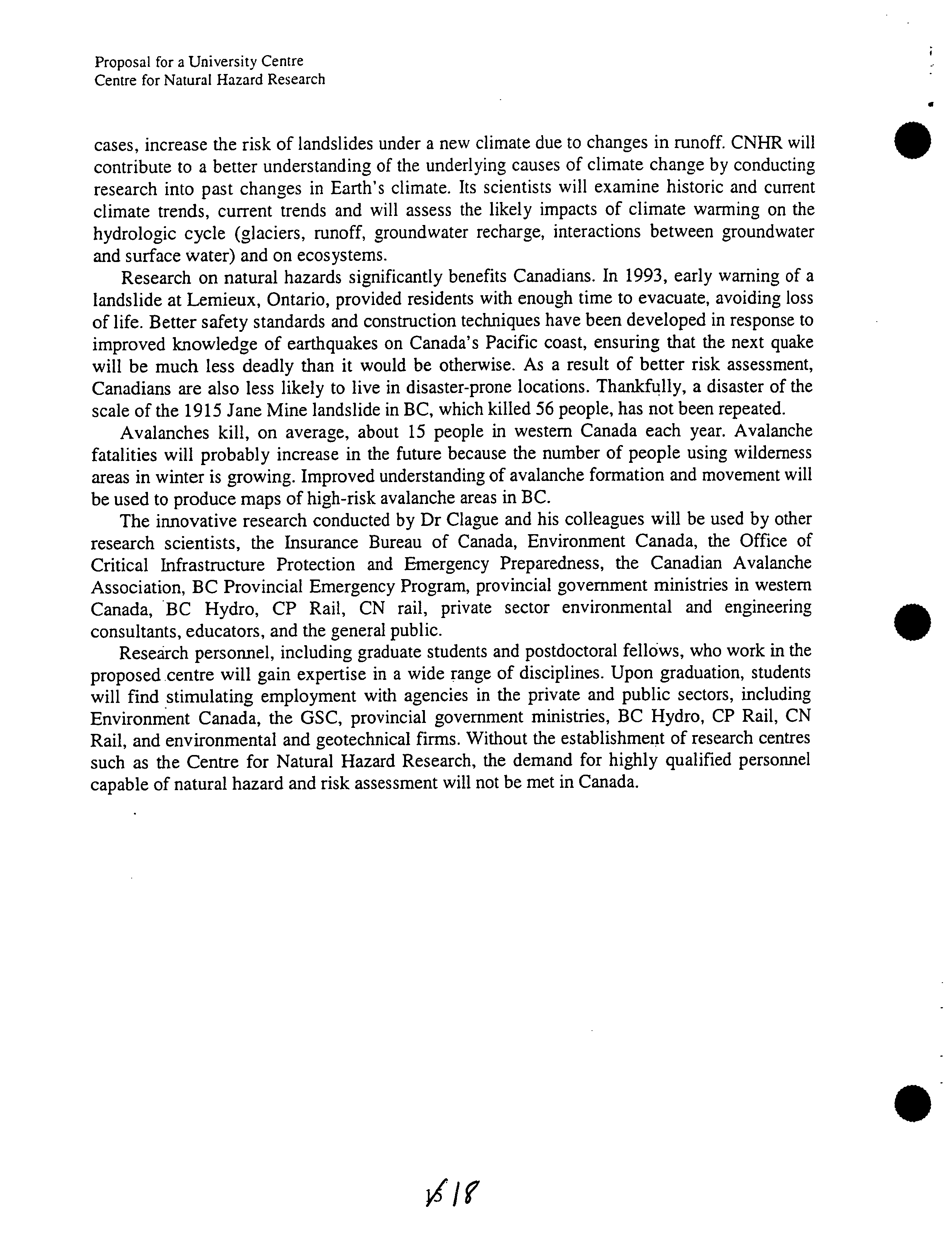S.05-64
SIMON FRASER UNIVERSITY
Senate Committee on University Priorities
?
Memorandum
TO:
Senate
?
FROM:
?
John Waterhoi.
Chair, SCUP
Vice President,
RE:
Centre for Natural Hazards Research
?
DATE: ?
April 22,
(SCUP 05-041)
Attached is the proposal for the establishment of the Centre for Natural Hazards
Research submitted for consideration by Dr. Mike Plischke, Dean, Faculty of Science.
This will be a Schedule A Centre reporting to the Dean, Faculty of Science in
accordance with Policy R 40.01.
The Senate Committee on University Priorities reviewed the proposal at its April 20,
2005 meeting, and it was unanimously approved. Once approved by Senate, the
proposal will be submitted to the Board of Governors.
Motion:
S ?
That Senate approve and-recommend to the Board of Governors the establishment
of the Centre for Natural Hazards Research as a Schedule A Centre under Policy
R40.01.
Attach.
c. M. Pinto
M. Plischke
J. Clague
G. Nicholls
0
SOUP 05 - 041
a
?
SIMON FRASER UNIVEKz,iix
MEMORANDUM ?
OFFICE OF VICE-PRESIDENT, RESEARCH
TO: Glynn Nicholls, Secretary
Senate Committee on University
Planning (SCUP)
RE: Centre for Natural Hazards
Research
FROM: B. Mario Pinto
Vice-President, Research
DATE: April 8, 2005
Attached is a proposal from Dr. Michael Plischke, Dean, Faculty of Science, for
the establishment of the Centre for Natural Hazards Research as a Schedule A Centre.
The Governing Committee for Centres and Institutes recommends that the
Centre be granted approval by SCUP. Once approved by SCUP, the proposal is to be
forwarded to Senate, followed by submission to the Board of Governors.
Governing Committee:
r. John H. Waterhouse
ice-President, Academic and Provost
Dr. B. Mario Pinto
Vice-President, Research
Attachment
C:
?
Dr. Michael Plischke, Dean, Faculty of Science
Dr. Diana Allen, Chair, Department of Earth Sciences
Dr. John Clague, Department of Earth Sciences
1.
SIMON FRASER UNIVERSITY
?
Office of the Dean of Science
?
MEMORANDUM
TO: J.H. Waterhouse
Vice-President Academic
RE: Centre
for
Natural Hazards Research
FROM: Dr. Michael Plischke, Dean
?
Faculty of Science
DATE: March 17, 2005
I support the enclosed proposal from Professor John Clague, Department of
Earth Sciences, for the establishment of a Centre for Natural Hazards Research at Simon
Fraser University. If approved, this will be a Schedule A Centre, reporting to the Dean
of Science.
The proposed constitution seems to be in order with appropriate provisions for
appointment of a Director and other administrative procedures. I note that item 6 of the
constitution envisages the creation of a new full-time position for a Manager. I will try
to find the resources to create such a position but cannot guarantee that these resources
will be available in fiscal year 2005/2006.
11
MAe
Michael Plischke
c Diana Allen
John Clague
r
c2.
SIMON FRASER UNIVERSITY
Department of Earth Sciences
?
MEMORANDUM
TO: Mike Plischke, Dean of Science
?
FROM: Diana Allen, Chair
RE:
Centre for Natural Hazard Research
?
DATE: March 16, 2005
Mike,
Attached please find a copy of a proposal by Dr. John Clague for the establishment of a Centre for
Natural Hazard Research (CNHR) at Simon Fraser University. As you will recall, CNHR was central
to an infrastructure request from CFI, which was backed by the University last year. While the
proposal did not receive funding, the researchers involved, and most particularly Dr. Clague, are
extremely committed to moving forward with the establishment of the Centre itself.
The Department of Earth Sciences recognizes that it has a very strong group of faculty doing
research in the area of natural hazards. This strength is translated to our graduate and undergraduate
students,
vis a vis
training. Commitment on the part of the Department to this area of research is seen
in our support of the nomination of Dr. Gwenn Flowers to a Tier II CRC in glaciology (glaciers are a
key geologic hazard on the west coast of BC). In our departmental review last year we noted that
Environmental Geoscience at SFU has seen a rapid period of growth and has become one of the
strongest research programs in Canada. A Centre for Natural Hazards Research will ensure that this
.
wth continues and will lead to SFU becoming an international centre for environmental geoscience
earch.
-
Diana Allen, Chair
0
a
CONSTITUTION
CENTRE FOR NATURAL HAZARD RESEARCH
1. OBJECTIVES
The activities and programs of the Centre for Natural Hazard Research (CNHR) are intended to
promote teaching and research in the field of hazardous Earth processes and natural disasters.
CNHR supports and initiates research, publication, non-credit and credit instruction, colloquia,
conferences, visiting speakers and researchers, and national and international collaborations. In
support of these objectives, CNHR provides support to individual, departmental, and cross-
departmental activities at Simon Fraser University in the area of natural hazard research.
2. ADMINISTRATION
2a.
The Centre for Natural Hazard Research shall be governed in accordance with University
policies including R.40.01, CENTRES AND INSTITUTES. If this document and University
policies differ on any issue, University policy shall prevail.
2b.
The Centre for Natural Hazard Research is a Schedule A Centre (R.40.01, page 2) and comes
under the direct authority of the Dean of Science
3. APPOINTMENT OF DIRECTORS
3a.
The Director of CNHR shall be appointed by the President on the recommendation of the
Governing Committee for Centres, which in turn acts on the recommendation of the Dean of
Science and the advice of the Centre Steering Committee. Term of office shall normally be for
three years.
3b.
In the absence of the Director, an Acting Director may be drawn from the Centre Steering
Committee.
4. INTERNAL GOVERNING PROCEDURE
4a.
CNHR shall be governed by a Steering Committee made up of five Simon Fraser University
faculty members and up to three representatives from the community. The Steering Committee
shall include the Director and Manager of CNHR. Members will be appointed by
recommendation to the Dean of Science by the Director. Appointments shall be for a three-year
term.
4b.
The Steering Committee shall be chaired by the Director of the Centre. Meetings shall
normally take place at least twice a year.
5.
ASSOCIATE MEMBERS OF THE CENTRE FOR NATURAL HAZARD RESEARCH
The Centre for Natural Hazard Research shall consist of a body of interested associates from both
within the University and outside it and individuals linked to the Centre through the projects and
other activities it sponsors and supports.
FA
1/
Proposal for a University Centre
Centre for Natural Hazard Research
6. RESOURCE REQUIREMENTS
The activities of the Centre for Natural Hazard Research will be conducted using the existing
University infrastructure. No new library resources or space are required by CNHR. The Centre
requires one new full-time position - a Manager working under the supervision of the Director to
run CNHR, organize and coordinate its activities, and promote the Centre nationally and
internationally. A budget of $2000 per year is required to effect a visiting speaker series.
.
I
s.
Proposal for a University Centre
Centre for Natural Hazard Research
CENTRE FOR NATURAL HAZARD RESEARCH
Executive Summary
Natural disasters are complex phenomena; as such, approaches to risk reduction that rely on
single disciplines and linear thinking address only one aspect of the problem and tend to fail.
Success requires a broad-based, innovative approach; such an approach is central to the vision of
SFU's Centre of Natural Hazard Research (CNHR). CNHR is a network of physical, social, and
economics researchers working toward common goals, and integrated effectively into the larger,
non-academic community.
The Centre for Natural Hazard Research (CNHR) will be the first scientifically based, natural
hazard research facility in western Canada. CNHR will conduct innovative research on
geophysical processes that are a threat to the inhabitants and the economic infrastructure of the
region. The Centre will have a western Canadian focus; however, the findings of the research and
the methodologies developed will be transformative and will impact the whole of Canada and the
international community.
CNHR
Will
foster a program of inter- and multi-disciplinary natural hazard research involving
geologists, geomorphologists, remote sensing and geographic information system (GIS)
specialists, geophysicists, biologists, and social geographers. A key element of the Centre will be
the inclusion of public policy research on how to effectively transfer results of scientific research
to the people who need and can use it. The integration of physical science with social and policy
research at CNHR will lead the way in Canada to a society that is more resilient to natural
disasters, and where planning and investment result in more sustainable communities. CNHR
research will contribute not only to a fundamental knowledge base but also to improvements in
engineering design, better land-use decisions, and a more informed public.
The principal objectives of the Centre are to facilitate cooperation and collaboration among
natural hazard researchers and practitioners. The Centre will capitalize on existing strengths in
several departments and schools at SFU. It will also involve faculty at other universities in
western Canada, and Geological Survey of Canada (GSC) and US Geological Survey (USGS)
scientists. CNHR will showcase SFU as a centre of excellence in natural hazard research in
Canada and will attract the best graduate students to the university.
The Research
CNHR will mount an internationally recognized earth science research program aimed at better
understanding hazardous geophysical processes, principally earthquakes, tsunamis, volcanic
eruptions, avalanches, floods, and landslides, and at quantifying risks associated with these
processes. Research will also be conducted on related environmental issues such as the impacts of
climate change on natural processes and the landscape. The Centre's program will have three
main elements: (1) original and innovative scientific research on natural hazards; (2) training of
graduate and senior undergraduate students and postdoctoral fellows for professional careers in
the private sector, government, and schools and universities; and (3) transfer of scientific
knowledge to the public, emergency preparedness personnel, and government policy makers,
from whom CNHR will seek input on the types of information they require.
The major research thrusts of CNHR (and its principal researchers) are:
Proposal
for
a University Centre
Centre for Natural Hazard Research
0Earthquakes and tsunamis
(SFU: Calvert, Clague, Hutchinson, Mathewes, Stead; others:
Atwater, Bobrowsky, Hyndman, Rogers, Spence, Wang)
The Cascadia subduction zone, where the oceanic Juan de Fuca plate moves eastward beneath
North America, extends from northern California to central Vancouver Island. The proximity of
the subduction zone to the population centres of western British Columbia results in a significant
seismic risk, arising from three primary earthquake sources: (1) earthquakes within the
subducting oceanic slab, with sources at depths of 40 km and 80 km ("inslab earthquakes"); (2)
very large earthquakes at the boundary between the subducting and overriding plates
("subduction earthquakes"); and (3) earthquakes at relatively shallow depth (less than 20 km)
within the North American plate ("crustal earthquakes"). Recent geological studies indicate that
the average recurrence interval for the subduction earthquakes (of magnitude 8-9) is about 600
years. Although infrequent, these huge earthquakes are capable of damaging all cities on the West
Coast, from Portland to Vancouver; estimates of probable damage reach into the hundreds of
billions of dollars. They also generate large tsunamis that are a significant hazard to coastal
residents and infrastructure. Smaller (magnitude 6-7) crustal and inslab earthquakes are much
more frequent and pose an even greater hazard than larger subduction quakes. Ten crustal and
inslab earthquakes have occurred in southwestern BC and northwestern Washington in the last
130 years; the most recent of these, in February 2001, caused over $1 billion damage. An
earthquake on Vancouver Island in 1946 was larger than the catastrophic quake at Kobe, Japan, in
1995, which caused over $200 billion damage. Unfortunately, the likelihood and locations of
future crustal and subcrustal earthquakes in BC are unknown because. the faults on which they
in occur have not been identified and studied, and the pattern of deformation of the crust in
southwestern BC has not been adequately documented.
CNHR researchers will conduct research aimed at determining the frequency, magnitude, and
effects of earthquakes in the recent geologic past. The focus of the research will be western BC,
where the earthquake threat is greatest. The research will contribute to an understanding of
earthquake sources and the damage likely to be caused by future earthquakes. Specific research
topics include geological investigations of prehistoric earthquakes and tsunamis, geophysical
modelling of surface deformation related to strain accumulation in the crust, assessment of the
liquefaction potential of sediments in earthquake-prone areas, the response of rock slopes to
seismic shaking, three-dimensional imaging of the near-surface and deeper crust to identify faults
capable of strong earthquakes, and onshore mapping and interpretation of geological features
indicative of recent crustal deformation. The research program will include collaborative studies
with GSC and USGS geophysicists and geologists.
Landslides
(SFU: Clague, Stead, Ward; others: Bobrowsky, Cruden, Evans, Geertsema, Hungr)
Research will be conducted on the causes, mechanisms, distribution, and age of landslides in
western Canada to provide a better understanding of landslide hazard and risk. CNHR will
collaborate with the University of Alberta, UBC, BC Forest Service, and the GSC to create a
broad-based, cooperative landslide program. The CNHR program will include field-based studies
of landslides, mapping, laboratory investigations of soil properties.
The main areas of CNHR landslide research will be: (1) characterization of landslides in
forested terrain in BC; (2) risk assessment in forestry-related landslides; (3) integrated numerical
•
modelling and field instrumentation of major rockslides; (4) coupled groundwater-mechanical
modelling of landslide failure mechanisms;
(5)
application of rock and soil engineering principles
j -;i.
Proposal for a University Centre
Centre for Natural Hazard Research
in landslide hazard assessment; (6) application of GIS in landslide investigations; (7) application
of remote sensing techniques in landslide research; (8) damage mechanisms, with particular
emphasis on rock slope failures; (9) application of acoustic emission techniques in the
investigation of rock slope failures; and (10) analysis of rock-slope stability in fiords and
modeling of tsunamis that would be produced by failures of fiord walls.
Avalanches
(SFU: Clague; others: McClung)
Avalanches kill, on average, about 15 people in western Canada each year. The winter of 2002-
2003 was particularly deadly - more than 30 skiers, snowmobilers, and climbers lost their lives in
the mountains of BC. Avalanche fatalities will probably increase in the future because the number
of skiers and snowmobilers using wilderness areas in winter is growing.
CNHR will support the research of Dr McClung (UBC, Geography), one of Canada's top
avalanche authorities. Dr McClung will work with Dr Clague and his students to produce maps of
high-use winter recreation areas in BC that depict avalanche hazards and risk. The maps will be
made available to the public and to groups responsible for public safety through a partnership
with the Canadian Avalanche Association. Public meetings will be jointly organized by CNHR
and the Canadian Avalanche Association to educate winter recreationists in order to reduce
avalanche injuries and loss of life.
Volcanism
(SFU: Clague, Williams-Jones; others: Hickson, Russell, Shimamura, Simpson,
Singhroy, Smith, Stasiuk)
CNHR and the GSC will collaborate on research on hazards posed by young volcanoes in western
Canada, including Mount Baker, Mount Garibaldi, Mount Cayley, and Mount Meager, with
insights on aspects of active volcanism from other areas (e.g., Central America, Hawaii). The
hazards include ash fallout, pyroclastic flows, landslides, lahars (volcanic debris flows), outburst
floods from lakes impounded by landslides on the flanks of volcanoes, and downstream
aggradation of floodplains. Dr Clague has collaborated with Drs Simpson and Stasiuk (GSC) in a
hazard study of Mount Meager volcano and plans to undertake a similar study with them on
Mount Baker lahars in the Fraser Valley near Sumas. Dr. Williams-Jones integrates geophysical
observations with geochemical and remote sensing data to investigate precursory eruption signals
and the mechanisms that trigger eruptions. The focus of CNHR research will be documenting
downstream effects of eruptions and landslides on volcanoes using stratigraphic and geophysical
methods, and furthering our capabilities to predict volcanic eruptions.
Floods
(SFU: Clague, Brennand, Flowers, Hickin; others: Evans, Geertsema, Whitfield)
One of the greatest hazards in Canada is flooding. The 1948 Fraser River flood caused about
$200 million damage (in 2003 dollars). Today some $10 billion in infrastructure lies on the Fraser
River floodplain behind protective river dykes and is at risk from large floods. CNHR scientists
and students will examine different types of floods in western Canada to better understand their
causes and to evaluate risk to existing economic infrastructure on floodplains. Flood types that
will be studied include rainfall- and snowmelt-triggered floods, ice-jam floods, and outbursts
from moraine-, glacier-, and landslide-dammed lakes. Flood occurrence will be evaluated within
the context of climate change. Research will focus on antecedent conditions associated with
different types of floods, relations between flooding and high sediment supply to rivers,
floodplain hazard mapping, and quantification of flood risk. Flood research will involve
il
Proposal for a University Centre
Centre for Natural Hazard Research
collaborations with hydrologists at UBC, the National Hydrology Research Centre in Saskatoon,
and the BC Government.
Climate change (SFU: Allen, Brennand, Clague, Flowers, Lertzman, Mathewes; others: Evans,
Moore, Whitfield)
The possibility of rapid climate change caused by human modification of the Earth's atmosphere
is increasingly being recognized as a hazard. CNHR research in this area will focus on impacts of
climate warming on physical processes and the landscape. Particular attention will be given to
destabilization of mountain slopes due to massive snow and ice loss, melt of permafrost, changes
in the frequency of outburst floods from glacier- and moraine-dammed lakes, impacts on
groundwater resources, interaction of groundwater with surface waters, impacts of sea-level rise
on shorelines and fresh water resources, changes in vegetation, and changes in river hydrology
and planform. The
'
research will involve mapping, geomorphic, hydrologic/hydrogeologic,
stratigraphic, sedimentological, and paleoecological studies, numerical modeling, and comparison
of aerial photographs spanning the last 70 years.
Sea level may rise under a warming climate due to melting of glaciers, thermal expansion of
oceans, and changes in ocean circulation. A rise in sea level will result in more frequent flooding
of low-lying coastal
,
areas, erosion of some shorelines, and seawater incursion into freshwater
aquifers, adversely affecting coastal development. CNHR and the Centre for Coastal Studies will
model the impacts of various sea-level rise scenarios on the BC coast. The modelling will utilize
field observations, detailed topographic maps produced from aerial photographs, and a GIS.
•
CNHR researchers will use downscaled global climate model predictions to drive hydrologic
models to determine runoff and groundwater recharge. By coupling hydrologic and
hydrogeological models, they will determine impacts on groundwater levels, interactions with
surface waters, and seawater intrusion. They will also conduct process-based field studies and
undertake glaciological modeling to address specific questions related to glacier-climate
interactions. Through Dr Gallaugher, the Centre for Coastal Studies will organize community
meetings in areas where critical research is being planned or conducted in order to involve the
public and other stakeholders.
Remote sensing (SFU: A. Roberts, and numerous other CNHR researchers)
LIDAR, InSAR, airborne digital multispectral, photogrammetric, and other spatial data will be
integrated in natural hazard studies under the direction of Dr A. Roberts and in cooperation with
CCRS. The research projects supported are diverse. As one example, Drs Clague and Roberts will
conduct research aimed at making high-resolution multispectral digital images available for
spectral interpretations, interactive photographic interpretation, and softcopy photogrammetric
production of custom digital elevation models (DEM).
Public policy and communications
(SFU: Anderson, Clague, Gallaugher, Pierce; others: Haque,
Pearce, Slaymaker)
Reducing the human and economic costs of natural disasters does not lie wholly within the realm
of science and technology. Because disaster risk reduction is a human-centred issue, it also has
political, sociological, economic, and psychological dimensions. Two of the principal reasons for
establishing a Centre for Natural Hazard Research are to increase public awareness of natural
.
hazards, and to influence public policy so as to reduce economic losses and injuries from natural
disasters. Key to CNHR's program of reducing disaster losses is research leading to hazard
Proposal for a University Centre
?
UI
Centre for Natural Hazard Research
identification and vulnerability analysis that is integrated into community planning and decision-
making. Research on public policy can help shape land-use practices and resource management.
Policy research will be conducted on societal vulnerability and resilience to natural disasters,
societal preparedness for natural disasters, risk perception, disaster management systems, disaster
planning and training, disaster forecasting, reconciliation of natural hazard research with human
well-being, psychological and social impacts of natural disasters, community response to natural
disasters, sustainable development in areas of potential natural disasters, and integration of
scientific information into the political decision-making process. The research will be fostered
through partnerships with the Disaster Research Institute of the University of Manitoba (Dr
Emdad Haque) and the Insurance Bureau of Canada.
The research of Drs Slaymaker, Haque, and Pierce bridges the very real and formidable gap
that exists between scientific analysis of natural hazards and the need for public action. CNHR
will lease video-conferencing facilities at the Morris J. Wosk Centre for Dialogue to enable Drs
Slaymaker, Haque, and Pierce to conduct research on methods for facilitating the integration of
information gathered by scientists at the Centre into the public and political decision-making
process. CNFIR will bring together people involved with natural hazards, including academics
and practitioners in the private sector, universities, and government, in person or by video-
conferencing, to exchange ideas, information, and data. Education and social change are
dependent on such an exchange.
Research projects will be jointly sponsored by Simon Fraser University and agencies
responsible for public safety. Faculty, graduate students, and postdoctoral fellows will involve the
public and other stakeholders in their projects through community workshops and presentations.
Information and key findings will be reported to the public and to public officials in an
understandable and useful form through reports, posters, maps, websites, and articles in
newspapers and magazines.
Policy research at CNHR will complement that of the recently established Centre for Coastal
Studies at SFU. The Centre for Coastal Studies actively promotes public awareness of research
developments that link science with local knowledge in an effort to effect policy change. It is able
to facilitate multi-stakeholder dialogue, involving outreach and research partnerships with all
levels of governments, including First Nations, and with community and industry groups, NGOs,
and academics, to identify solutions based on academic research and practical knowledge. Dr
Patricia Gallaugher, Director of the Centre for Coastal Studies, has strong connections with
government and community groups. The Centre for Coastal Studies also coordinates the Linking
Science with Local Knowledge node of the DFO/SSHRC-funded national Ocean Management
Research Network (OMRN).
Dr Anderson is developing innovative, space-based and terrestrial wireless communication
systems that will allow CNHR researchers to communicate efficiently with one another, both in
the field and the office, creating a "virtual research centre" for researchers who are not based at
SFU. They will also be useful for informing the public and emergency planners about natural
hazards.
CNHR Researchers
SFU
• Diana Allen (Earth Sciences) - groundwater, climate change
0
• Peter Anderson (School of Communication) - communication emergency preparedness
Ito.
Proposal for a University Centre
Centre for Natural Hazard Research
• Tracy Brennand (Geography) - geomorphology. glaciation, sedimentology
• Andy Calvert (Earth Sciences) - geophysics
• John Clague (Earth Sciences) - Quaternary geology, climate change, natural hazards
• Gwenn Flowers (Earth Sciences) - hydrology, glaciers, climate change
• Patricia Gallaugher (Centre for Coastal Studies) - science and public policy
• Ted Hickin (Geography and Earth Sciences) - floods
• Ian Hutchinson (Geography) - earthquakes and tsunamis
• Ken Lertzman (School of Resource Management) - wildfire, climate change
• John Pierce (Geography) - economic geography, policy
•
Rolf Mathewes (Biological Sciences) - climate and environmental change
• Arthur Roberts (Geography) - remote sensing
• Dou g
Stead (Earth Sciences) - landslides, rock slope modelling
• Brent Ward (Earth Sciences) - Quaternary geology, landslides
• Glyn Williams-Jones (Earth Sciences) - volcanology, remote sensing, applied geophysics
Others
• Brian Atwater (USGS) - earthquakes and tsunamis
• Peter Bobrowsky(GSC) - earthquakes and tsunamis
• David Cruden (University of Alberta, Civil Engineering) - landslides
• Stephen Evans (University of Western Ontario) - landslides, floods, climate change
• •. Marten Geertsema (BC Forest Service) - landslides and forestry, floods
• Emdad Haque (University of Manitoba, Natural Resources Institute) - social and public
policy
• Cathie Hickson (GSC) - volcanology
• Oldrich Hungr (UBC, Earth and Ocean Sciences) - landslide hazards and risk
• Roy Hyndman (GSC) - geophysics, neotectonics
• Murray Journeay (GSC) - neotectonics, data management
• Arthur Lerner-Lam (Lamont Doherty Earth Observatory, Director of Center for Hazards and
Risk Research) - partnership, student and researcher exchanges
• David McClung (UBC, Geography) - snow avalanches
• Dan Moore (UBC, Geography) - hydrology, climate change
• Garry Rogers (GSC) - seismology
• Kelly Russell (UBC, Earth and Ocean Sciences) - volcanology
• Willy Scott (USGS) - volcanology
• Kirstie Simpson (GSC) - volcanology
• Olav Slaymaker (UBC, Geography) - geomorphology, social and public policy
• Mark Stasiuk (GSC) - volcanology
• Chris Tucker (Office of Critical Infrastructure Protection and Emergency Preparedness) -
emergency preparedness
• Paul Whitfield (Environment Canada, Adjunct Earth Sciences, SFU) - hydrology, climate
change
. More than 100 researchers from universities, government agencies, and private sector firms will
contribute to the Centre for Natural Hazard Research. These researchers will supervise students
and collaborate on projects.
'If.
Proposal for a University Centre
Centre for Natural Hazard Research
Training
CNHR will train university students and postdoctoral fellows in an area of critical importance to
Canada. Consistent with the SFU Strategic Research Plan, the Centre will be interdisciplinary and
will create a.new model for educating students in earth sciences at SFU. The unique environment
of the Centre will create a stimulating training environment by exposing students to geology,
physical and social geography, economics, biology, geophysics, physics, chemistry, mathematics,
and computing science. SFU has a world-class school of computing science and strong programs
in remote sensing, environmental earth sciences, resource management, and communications.
PhD and MSc students and postdoctoral fellows will study and conduct research under the
direct supervision of Drs Allen, Anderson, Brennand, Calvert, Clague, Flowers, Gallaugher,
Hickin, Hutchinson, Mathewes, Pierce, Roberts, Stead, Ward, and Williams-Jones. Some students
will be co-supervised by: Drs Bobrowsky, Evans, Hickson, Hyndman, Rogers, and Stasiuk
(GSC); Drs Hun
g
and McClung (UBC); Dr Menounos (University of Northern BC); and others.
Some projects will be supported by government agencies and private sector firms, including the
GSC, BC and Alberta Government ministries, Environment Canada, BC Provincial Emergency
Program, Canada Office of Critical Infrastructure Protection and Emergency Preparedness, BC
Hydro, CN Rail, and CP Rail. Such support will ensure practical training that will lead to
rewarding and interesting jobs for students when they graduate from SFU. Graduates will find
employment with the aforementioned agencies, as well as with private sector geotechnical and
environmental
firms.
training
Examples of
Access to dedicated, knowledgeable faculty, will make SFU an extremely attractive location for
gifted graduate students. The following are a few examples of opportunities that will be available
to students at CNHR.
CNHR projects that involve acquisition of offshore seismic data will provide excellent
training for students under the supervision of Dr Calvert. The students will process and interpret
seismic data using the state-of-the-art computation facilities included in this proposal.
Dr Stead's research will provide students with training in the use of innovative computer
simulation, visualization, and modelling tools for landslide hazard research. Graduates with
strong backgrounds in earth science and engineering geology, and with skills in state-of-the-art
visualization/modelling techniques will be highly sought after by employers in industry and
academia. Dr Stead has already trained numerous students who are now occupying senior
positions in Canadian geotechnical companies.
Dr A. Roberts provides undergraduate and graduate students with training in remote sensing.
Environmental monitoring and resource mapping and evaluation are of crucial importance to
Canada and can be met, in part, through remote sensing. Canada's environmental and resource
industries are not making full use of remote sensing because they lack a sound understanding and
appreciation of its benefits to their business. CNFIR will help bridge this gap by developing
simple procedures for resource management applications, and by training skilled researchers in
the use of these procedures in data analysis.
Drs Gallaugher, Haque, Pierce, Slaymaker, and other researchers will facilitate the social and
policy training of graduate students involved in natural hazard research. They will also foster
collaborative research and will involve community stakeholders in CNHR activities. There is a
need at the PhD and MA/MSc levels to develop interdisciplinary expertise in public policy and
Proposal for a University Centre
Centre for Natural Hazard Research
5
planning through the establishment of 'best practices' guidelines in the design and
implementation of remedial action plans. Equally important, and relating to collaborative
research, is the need to better understand adaptive behaviour in the face of natural risk and
uncertainty. SFU's Centre for Policy Research on Science and Technology (CPROST), the
Centre for Public Policy Research, and the newly created Centre for Behavioural Economics
afford a unique opportunity to pool expertise with CNHR, and train students in the underlying
behavioural, strategic, and counterfactual patterns of decision-making under uncertainty.
Research Collaborations and Partnerships
Faculty involved with CNHR collaborate with natural hazard researchers in universities
throughout Canada and abroad. For example, Dr Clague has long-standing collaborations with Dr
Mathewes (Biological Sciences) and Dr Hutchinson (Geography) to assess botanical evidence for
climate and environmental change, earthquakes, and tsunamis. Clague will collaborate with Dr
Anderson (School of Communication) to develop technologies for real-time wireless transmission
of field data; with Dr A. Roberts (Geography) on remote sensing imagery for natural hazard
research; and with Dr Gallaugher (Centre for Coastal Studies) on public policy concerning natural
hazards.
SFU has one of the top-ranked schools of computing science in North America, with experts
in computational science, graphics, and 3-D visualization, including Drs T. Moller, M. Ester, and
R. Thang. Faculty members in the Department of Earth Sciences are involved with this group in
state-of-the-art computer simulations of natural hazards, including rock slope modelling using
S .
coupled finite and discrete element techniques and the use of virtual reality technology.
Collaborators at UBC include Drs Clarke, Eberhardt, and Hungr (Earth and Ocean Sciences;
•
expertise in glaciology, landslides, and rock slope modelling), Drs Bovis, Church, McClung,
Moore, and Slaymaker (Geography; climate change, hydrology, landslides, floods, and
• avalanches). Dr Clague and Dr Smith, and Dr Allen and Dr Moore collaborate on research on
climate change. Dr Cruden (Civil Engineering, Univ. of Alberta) will participate with Dr Stead
and others in landslide research at CNHR. Dr Calvert and Dr Spence (Earth and Ocean Sciences,
Univ. of Victoria) will conduct research the structure of the Pacific margin. The two recently
worked together on the SHIPS project in the Strait of Georgia and Puget Sound, and are currently
collaborating on the CASSIS project. These academic connections, extending beyond SFU,
strengthen the Centre's research and its program of instruction for graduate students.
CNHR researchers will consult with officials from the Canada Office of Critical
Infrastructure Protection and Emergency Preparedness, the Provincial Emergency Program,
provincial government ministries, BC Hydro, CN Rail, and CP Rail in order to tailor research
projects to meet the needs of these groups, create mechanisms for transfer of useful scientific
knowledge, and provide students with opportunities to carry out research projects with the public
and private sectors.
Drs Clague and Evans work with Mr Geertsema, a landslide expert with the BC Forest
Service. Ninety percent of BC's forests are publicly owned, and the BC Ministry of Forests is
responsible for their management. CNHR research will be vital for quantifying future risks facing
BC's forests. Dr. Stead is the Forest Resources BC Endowed Chair at SFU and collaborates
extensively with scientists in the Ministry of Forests and the private sector on slope stability in
•BC.
uI3
Proposal for a University Centre
Centre for Natural Hazard Research
A partnership with the Geological Survey of Canada has been established through a formal,
signed agreement to allow GSC and CNHR researchers to collaborate on projects of joint interest.
The GSC has groundwater, landslide, volcano, and earthquake monitoring programs. Dr Clague
was a research scientist at the GSC for 24 years before coming to SFU, and he has a strong record
of collaboration with scientists who are leading these programs, including Drs Blais-Stevens,
Bobrowsky, Brooks, Couture, Dragert, Evans, Hickson, Hyndman, Rogers, Simpson, and Stasiuk,
and Mr Shimamura. Dr Allen currently collaborates with Drs Joumeay and Turner on
groundwater resources and public outreach. Dr Williams-Jones collaborates with Dr Simpson.
Establishment of CNHR will also facilitate new partnerships with the Institute for Catastrophic
Loss Reduction (University of Western Ontario), Disaster Research Institute (University of
Manitoba), Insurance Bureau of Canada, and the Canadian Avalanche Association.
Dr Stead is currently collaborating on natural hazard research with the Engineering Geology
Group at ETH, Switzerland, and with the University of Exeter, England. His work on the Randa
Rockslide instrumentation scheme with Dr Eberhardt (University of BC) is one of the most
innovative and multidisciplinary rock slope failure investigations undertaken to date, involving
engineering geologists, rock mechanics engineers, hydrogeologists, and geophysicists. Dr Stead
also collaborates with Dr Allen on the application of groundwater modelling in the investigation
of slope hazard phenomena; with Dr Ward on the application of soil mechanics principles in
investigations of forestry-related slope failures; with Dr Hungr on landslide simulation using a
suite of numerical codes, including dynamic rheologic, finite element, finite difference, and
distinct element models; with private sector researchers in the use of GIS to delineate slope
hazards; with BC Hydro in the application of numerical codes to simulate slope failure; and with
Parks Canada and the BC Ministry of Forests in remote sensing applied to landslides. CNH.R's
laboratory and field infrastructure is essential to sustain and further these collaborations.
Dr A. Roberts has research links with BC Provincial Government ministries, the Canadian
Forest Service, Environment Canada, Department of Fisheries and Oceans, GSC, Parks Canada,
and social service agencies. He will foster new linkages with other university, government, and
private firms by capitalizing on the benefits of an integrated approach to spatial information
science.
Dr Mathewes works with several scientists in other countries on reconstructing past climate
and vegetation: Drs T. Ager (USGS), 0. Lian (Univ. College of Fraser Valley), W. Shotyk
(Director, Inst. of Environmental Geochemistry, Univ. of Heidelberg), and C. Whitlock (Univ. of
Oregon). He is also collaborating on a Swedish-Canadian research project, led by Drs B.
Wohlfarth (Univ. of Stockholm) and J. Clague, on climate and vegetation change over the last
2000 years. This project involves student and faculty exchanges among four universities (SFU,
Lund Univ., Univ. of Stockholm, and Okanagan Univ. College), and is supported by the Swedish
government through its Foundation for International Cooperation in Research and Higher
Education.
Dr. Williams-Jones collaborates with scientists in Canada and abroad on active volcanism: F.
Amelung (Univ. Miama), T. Elias, M. Poland, and A. Sutton (USGS), L. Flynn, K. Horton, and
R. Wright (Univ. Hawaii), J. Gottsmann (CSIC, Spain), D. Johnson (Univ. Washington), H.
Rymer and D. Rothery (Open Univ., UK), and J. Stix (McGill Univ.). His collaborative studies of
active volcanoes in the Americas, Europe, and Hawaii will provide insight into potential future
activity at dormant Canadian volcanoes.
Internationally, Dr Clague and other CNHR researchers also collaborate with Drs J. Chow
(Univ. of Taiwan), M. Cisternas (Univ. Catolica de Valparaiso), D. Clark (Western Washington
Proposal for a University Centre
Centre for Natural Hazard Research
Univ.), E. Eberhardt (ETH Zurich). A. Goodie (Oxford Univ.), F. Guadagno (Univ. of
Benevento), Y. Ikeda (Univ. of Tokyo), F. Nanayama (Geol. Survey of Japan), A. Nelson
(USGS), Y. Ota (Senshu Univ.), P. Owens (Cranfield Univ.), D. Petley (Univ. of Warwick), K.
Sassa (Kyoto Univ.), K. Satake (Geol. Survey of Japan), C. Scavia (Turin Polytechnic Univ.), T.
Spencer (Cambridge Univ.), I. Stewart (Univ. of Edinburgh), Y. Tsuji (Univ. of Tokyo), K. Ueda
(Univ. of Tokyo), and Y. Yang (Nanjing Univ.).
Drs Clague, Anderson, and Hutchinson will establish collaborations with international
researchers working on tsunami hazards and risk in the Asia-Pacific region. The tsunami disaster
in the Indian Ocean in December 2004 highlighted the need for scientific research on the tsunami
threat in the North Pacific and for studies of state-of-the-art communication systems for providing
timely warning of approaching tsunamis.
Benefits of CNHR
The Centre for Natural Hazard Research will support research that will lead to major,
improvements to society and the environment in Canada, and will galvanize natural hazard
research and policy-making.
CNHR can be considered a vitally important "insurance policy" for Canada. Economic
damage and personal loss caused by natural disasters are increasing rapidly. Losses in the
1990s were 17 times larger than those in the 1960s. In the last 50 years alone, losses due to
natural disasters in Canada have exceeded
$25
billion, and even greater losses can be expected
.
in the future. The long-term goals of CNHR are to create a society that is more resilient to
natural disasters and to save Canada lives and billions of dollars in economic losses from
disasters. These goals will be achieved through innovative scientific research on natural
hazards, training of graduate and senior undergraduate students for professional careers in
earth science, and transfer of information to the people who need it. The direct benefits to
Canada, in addition to a reduction in losses from disasters, are improved public safety, a better-
informed public, and wiser land-use decisions. Indirect economic benefits include stimulation
of innovative engineering design and services to the public (e.g. seismic retrofitting of unsafe
buildings, innovative construction methods, and earthquake preparedness kits).
Specific benefits of CNHR to Canada are numerous. (1)
The National Building Code:
CNI-IR research will provide greater protection to Canadians and public and private
infrastructure through partnerships with the National Research Council of Canada (Institute for
Research in Construction) and Natural Resources Canada (earthquake and landslide hazard
programs). (2)
Land-use planning:
Improved understanding of natural hazards will aid land-
use planners in making the best possible use of their resources for protective structures such as
dykes, thus reducing the economic and social costs of both natural disasters and the protective
infrastructure. (3)
Critical infrastructure and hazardous waste:
Many hazardous natural
processes can damage critical infrastructure, including hazardous material storage facilities.
Spillage of pesticides and petrochemicals could imperil Canada's food and water supplies, with
significant health and economic impacts. Preventative measures and established clean-up
plans, made possible with information and strategies provided by CNI-IR, will reduce these
impacts. (4)
Security of food and water supply:
CNHR will contribute to the Federal
.
Government's goals of strengthening the security of the food supply and ensuring the safety of
drinking water, as stated in the most recent Speech from the Throne. (5)
Climate change:
Canada and the international community are working to mitigate the effects of climate change
Proposal for a University Centre
Centre for Natural Hazard Research
caused by human modification of Earth's atmosphere. CNHR research into the potential effects
of climate change will provide individuals, businesses, and policy makers with the information
they need to adapt to climate change and minimize its negative economic impacts. CNHR will
work to ensure that policies are developed to encourage adoption of techniques and technology
that will minimize impacts of climate change, especially drought and soil erosion. Partnerships
will be sought with policy makers, the agricultural industry, and insurers to accomplish this
goal. (6) Knowledge dissemination and emergency planning:
Major natural disasters can
have national, even global, effects. The earthquake in Kobe, Japan, in 1995, for example,
extended the recession in Japan, the second largest economy in the world. International
organizations, such as
UNESCO,
have played an active role in increasing awareness of natural
hazards, encouraging sound planning, land use, and construction, and facilitating the sharing of
information among researchers, policy makers, industry, and the public. CNI-IR will support
these ?
activities
?
by ?
disseminating ?
information, ?
not ?
only ?
locally ?
and ?
nationally, ?
but
internationally through partnerships with overseas natural hazard research centres. CNHR will
archive natural hazard information and make it available in a useful form to governments to
reduce the impact of future disasters. Research conducted by CNHR into the impact of natural
disasters on humans will lead to the creation of effective educational materials and emergency
plans. (7) Retention of HQP and business development:
Through improvements in
education, prevention, and emergency preparedness, CNHR will contribute to the retention of
businesses and HQP in Canada. It will also attract new economic ventures and encourage
skilled personnel to relocate here, thus promoting economic development. (8) Environmental
protection: CNHR will provide input into environmental impact assessment that will benefit
forestry and mining operations and the public.
Although they occur infrequently, natural disasters have a high social and economic toll
that should concern all Canadians. Potentially catastrophic earthquakes of magnitude 7 occur,
on average, once every 30 years on the West Coast. The most recent of these quakes, in
February 2001, caused about US $1 billion damage in Washington State. This damage,
however, pales in comparison to that of the earthquakes at Northridge, California (January
1994, magnitude 6.4), and Kobe, Japan (January
1995,
magnitude 7.1), which amounted to US
$20 billion and US $147 billion, respectively. Earthquakes larger than those at Northridge and
Kobe can occur in British Columbia. Damage from a large, shallow, crustal earthquake near
Vancouver or Victoria could reach several tens of billions of dollars, perhaps more. Research
at CNHR will provide information on the frequency and magnitude of past earthquakes and
tsunamis, and on the likely effects of the next large earthquake in the region. As part of the
immediate benefits of its research, CNHR will strive to have its information used when the
seismic provisions of the National Building Code of Canada, which ensure that buildings and
other structures are more earthquake-resistant, are revised. The information will also be useful
to emergency planners and officials in the BC Provincial Emergency Program, as it will allow
them to postulate scenarios that are more realistic in order to prepare for damage caused by
earthquakes.
The eruption of Mt. St. Helens in May 1980 and its recent reactivation demonstrates the
need for expanded research on Canadian volcanoes. The 1980 eruption claimed 57 lives and
caused more than US $1 billion damage. A similar eruption at Mt. Baker or Mt. Meager athe
the north end of the Cascade volcanic belt could affect populated areas of south-coastal BC.
Collaborative research at CNHR, GSC, and USGS will assess the probable impact of future
Y^ / (a
Proposal
for a
University Centre
Centre for Natural Hazard Research
eruptions in the region so that appropriate emergency preparedness measures can be
implemented.
Landslides cause $100-200 million in damage in Canada every year. As Canada's
population increases, more people will be at risk from landslides in mountain and rural areas.
This year marks the centennial of the Frank Slide, which destroyed part of the town of Frank,
Alberta, and claimed about 70 lives. Even small landslides, however, are a threat to
transportation infrastructure as they disrupt the movement of goods, and are costly to clear. For
example, in 1991, a small landslide near Logger's Creek, north of Vancouver, damaged a
major highway; the cost to clear and repair the highway was $7 million. Construction of more
roads and rail links increases the likelihood of transportation infrastructure being disrupted by
landslides. Moreover, the economic costs of landslides are not limited to roads and railways. In
the past, underwater landslides off the coast of British Columbia have destroyed wharves and
warehouses. In 1914, a landslide at Hell's Gate, BC, prevented salmon from returning to their
spawning grounds. Economic losses, in terms of reduced salmon runs, are estimated to be in
the hundreds of millions of dollars and are still being felt, almost ninety years later. CNHR will
conduct innovative research on landslides and rock mass creep, identify areas of high landslide
risk, and notify appropriate provincial and municipal agencies of its findings. Government
agencies will use this information to make informed and sensible decisions on expenditures of
monies for landslide prevention measures and remediation.
Floods are the most damaging natural hazard in Canada. Large floods can destroy bridges,
inundate populated land, and contaminate drinking water, causing major damage and.
•
disrupting normal economic activity. The 1948 Fraser River flood caused $200 million (2003
dollars) in damage and forced about 16,000 people from their homes. In 1993, a major flood in
Winnipeg caused $500 million in damage. Further development of Canada's hinterland will
result in increasing economic losses should a flood or other disaster strike. To reduce such
losses, CNHR will strengthen existing collaborations and establish formal partnerships with
the GSC, UBC, UVic, UNBC, University of Alberta, BC Hydro, Environment Canada, and
some BC Government ministries. The information provided by CNHR will be transferred to
the public, land-use planners, and government bodies to reduce exposure of people and
property to floods. The reduction in risk will be accomplished through government ordinances
that limit development on floodplains, improve dyking systems, and strengthen emergency
preparedness measures.
Protection of surface and ground water is a key concern to all Canadians, as evidenced by
the recent Walkerton tragedy. Dr Allen currently sits on the provincial Ground Water Advisory
Board that is developing recommendations for regulations pertaining to the Drinking Water
Protection Act and the Water Act. She collaborates with GSC, Environment Canada, BC
Ministry of Water, Land and Air Protection, Agriculture Canada, and university researchers.
CNHR scientists will undertake groundwater research aimed at better understanding
groundwater availability and vulnerability to contamination, the role of preferential pathways
for recharge and contaminant transport, resources sustainability in the face of climate change,
and the nature of interactions between groundwater and surface water.
Some natural disasters, such as floods and landslides, may occur more frequently as
climate changes due to global warming. Climate change could also cause sea level to rise due
S
to melting of glaciers, thermal expansion of oceans, and changes in ocean circulation. Sea-
level rise will cause more flooding in coastal areas as well as changes in the position of the
saltwater-freshwater interface in coastal areas. Mining and forest harvesting may, in some
Proposal for
a University Centre
Centre for Natural Hazard Research
a
cases, increase the risk of landslides under a new climate due to changes in runoff. CNI-IR will
contribute to a better understanding of the underlying causes of climate change by conducting
research into past changes in Earth's climate. Its scientists will examine historic and current
climate trends, current trends and will assess the likely impacts of climate warming on the
hydrologic cycle (glaciers, runoff, groundwater recharge, interactions between groundwater
and surface water) and on ecosystems.
Research on natural hazards significantly benefits Canadians. In 1993, early warning of a
landslide at Lemieux, Ontario, provided residents with enough time to evacuate, avoiding loss
of life. Better safety standards and construction techniques have been developed in response to
improved knowledge of earthquakes on Canada's Pacific coast, ensuring that the next quake
will be much less deadly than it would be otherwise. As a result of better risk assessment,
Canadians are also less likely to live in disaster-prone locations. Thankfully, a disaster of the
scale of the 1915 Jane Mine landslide in BC, which killed 56 people, has not been repeated.
Avalanches kill, on average, about 15 people in western Canada each year. Avalanche
fatalities will probably increase in the future because the number of people using wilderness
areas in winter is growing. Improved understanding of avalanche formation and movement will
be used to produce maps of high-risk avalanche areas in BC.
The innovative research conducted by Dr Clague and his colleagues will be used by other
research scientists, the Insurance Bureau of Canada, Environment Canada, the Office of
Critical Infrastructure Protection and Emergency Preparedness, the Canadian Avalanche
Association, BC Provincial Emergency Program, provincial government ministries in western
Canada, BC Hydro, CP Rail, CN rail, private sector environmental and engineering
consultants, educators, and the general public.
Research personnel, including graduate students and postdoctoral fellows, who work in the
proposed centre will gain expertise in a wide range of disciplines. Upon graduation, students
will find stimulating employment with agencies in the private and public sectors, including
Environment Canada, the GSC, provincial government ministries, BC Hydro, CP Rail, CN
Rail, and environmental and geotechnical firms. Without the establishment of research centres
such as the Centre for Natural Hazard Research, the demand for highly qualified personnel
capable of natural hazard and risk assessment will not be met in Canada.
0
X/f


